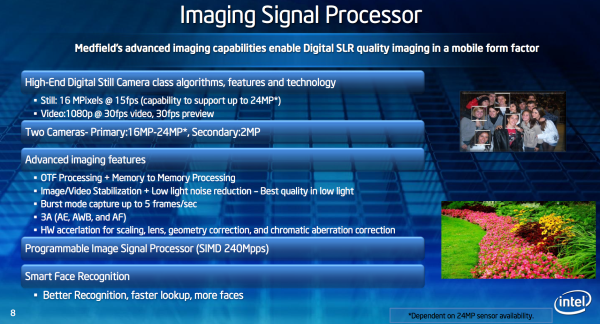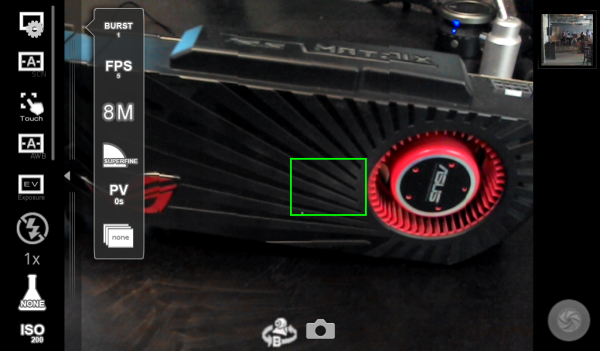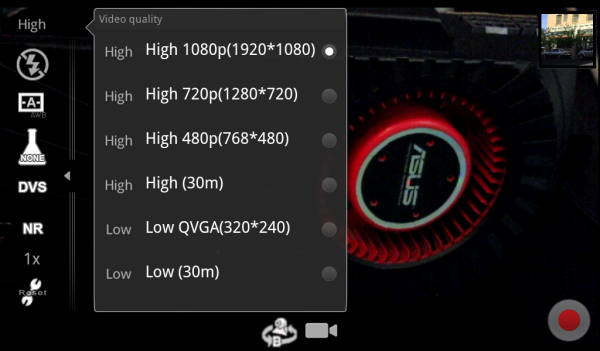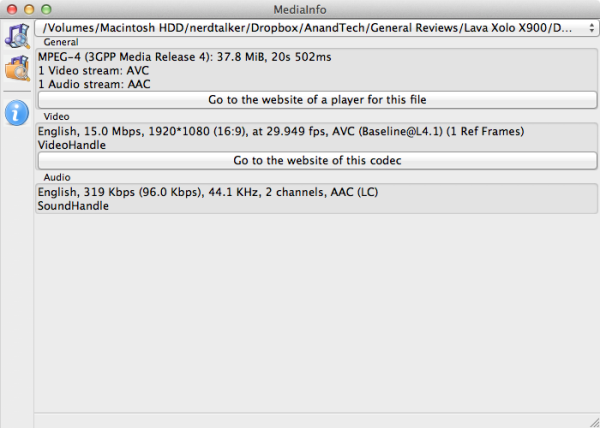Lava Xolo X900 Review - The First Intel Medfield Phone
by Brian Klug on April 25, 2012 6:00 AM ESTCamera is the other big axis of improvement with Medfield, as Intel has included a SiliconHive ISP with full support for up to 24 MP rear facing cameras and a 2 MP secondary camera. Intel acquired SiliconHive a while ago, and it has integrated their IP prominently inside the platform.
In addition all the features you need to support a smartphone camera are here, including AE, AWB, AF, lens shading and distortion correction, stabilization, and fixed pattern/dark noise subtraction. Intel is also quite proud of its burst functionality which enables up to 10 full size 8 MP images to be captured at up to 15 FPS.
I did some digging and found what CMOSes are being used in the Xolo X900 smartphone. The front facing camera is an Aptina mt9m114 1.3 MP 1/6“ CMOS with 1.9µm square pixels, and the rear facing camera is an Aptina mt9e013 8 MP 1/3.2” CMOS with 1.4µm pixels (3264 x 2448). The 8 MP rear facing system appears to possibly be from LiteOn. The optical system onboard is F/2.4 with 4.4mm focal length. The result is a thoroughly modern camera system that is up to par with what’s shipping in other devices right now. Interestingly enough, I can tell from poking around that Intel has tested the Medfield platform with a 14MP module as well.
The camera UI on the X900 is by far the most comprehensive of any smartphone I’ve encountered so far. The still shooting mode includes customization options for the burst mode and FPS, image capture size, compression level, and bracket modes in the top tab. Below that are scene modes (Auto, Sports, Portrait, Landscape, etc), focus modes (Auto, Infinity, Macro, Touch to focus), white balance (Auto, Incandescent, Daylight, etc), exposure, flash, color filters (None, Sepia, BW, Negative), ISO (100, 200, 400, 800), exposure time (1s to 1/500s), and auto exposure metering modes, phew. What’s really unique however are toggles under the happy face icon for advanced features like GDC (geometric distortion correction), XNR (extra noise reduction for low light), ANR (another noise reduction routine). These are usually things present in other ISPs, but I’ve never seen the option to play with them in any smartphone camera UI before. There are also some RAW options which, based on their labeling, I would assume allow you to save pre-Bayer demosaicing RAW data and YUV data, but I’m not sure where this data is stored after capture. Resetting the camera to defaults interestingly enough turns GDC, XNR, and ANR off, so it is in this mode that I captured sample images.
Burst mode works well, as does the camera UI. Images captured in burst mode are prefixed with BST instead of IMG when they’re stored, so you can tell the two apart later on the desktop. 8 MP images captured on SuperFine end up being just under 2 MB after JPEG compression.
To get to the bottom of still image quality, we turned to our regular set of evaluation tools, consisting of both photos taken in a fixed smartphone lightbox test scene with the lights on and off, with test charts (GMB color checker card, ISO12233, and distortion), and at our smartphone bench locations. I took these after resetting the camera to defaults, which again curiously disables GDC, XNR, and ANR. The result is some very strange higher order distortion in the chart (the chart is indeed flat and normal to the camera), but good spatial resolution in the ISO chart, I can see up to around 15 lp/ih in the vertical and 14 in the horizontal. White balance is a bit weird on the chart, but in the lightbox the white balance is pretty good. The X900 also illuminates the scene for focusing before taking the photo in the dark, which is something some smartphone OEMs are still not doing.
I’m pretty pleased with camera quality, it isn’t as good as some other smartphones that are out right now, but it’s very good. I suspect this is more a reflection of the optics (eg heavy distortion without geometrical correction) than ISP. I actually come away pretty impressed with all the options that have been made available, it’s obvious that lots of time and energy went into that part.
Video
The video capture UI unsurprisingly offers some of the same configuration options as the still shooting mode. Capture resolutions from QVGA to 1080p are offered, along with various MMS compatible settings like we’re used to seeing. The menu here also offers the ability to disable electronic video stabilization (DVS) and noise reduction (NR) which is awesome, especially since many find electronic video stabilization somewhat disconcerting. I disabled it for the test video since this results in the same behavior I saw with the Galaxy Nexus before Google ostensibly disabled it on the rear camera (but left it enabled on the front one). Anyhow, I’m grateful that the options are here, as the smartphone camera UI standard seems to be trending toward Apple’s minimalist tendency rather than exposing real options, but I digress.
To evaluate video capture quality on the X900, I took videos at the standard bench location at around the same time. The Medfield platform uses Imagination’s VDE285 video encoder. 1080p30 video recorded on the X900 is encoded at 15.0 Mbps H.264 Baseline with 1 reference frame. 720p30 video from the rear camera is encoded at around 8 Mbps with the same parameters, but interestingly enough front facing 720p30 video is encoded at 12Mbps. All three include 320 kbps AAC stereo audio.
Baseline H.264 is about par, but not the high profile that we’ve seen being done on other platforms like Exynos 4xxx or OMAP 4. Thankfully the baseline bitrate is good enough to produce good quality results, but again turning the encode parameters up a bit would enable better results with the same bitrate.
As we always do, I’ve uploaded the bench videos to YouTube and also made them available for direct download if you want to look at them without the transcode. Some small interesting points are how the videos are saved with a .3gp extension instead of the more common .mp4 (haven’t seen .3gp in a while, even if it’s acceptable), and also the 1080p video field of view is much narrower than the 720p field of view (clearly a center crop is being taken). Those notes aside, I have no issues with the 1080p video quality that’s produced, it looks good and has continuous auto focus. The 720p video has some weird decimation artifacts from downscaling, but nothing too bad, and 1080p maximum is usually what I scrutinize anyways.

























































106 Comments
View All Comments
diulaylomochohai - Thursday, April 26, 2012 - link
Where are the numbers for HTC 1X and 1S??? Let see how much INTC is off from latest and greatest from NVDA and QCOM???dwade123 - Friday, April 27, 2012 - link
Intel proves x86 can compete. With Intel's engineering and manufacturing advantages, Intel may soon surpass ARM in just about everything in the future. I still remember those who thinks ARM's transition to desktop is a threat to the entirety of Intel. Nope. It's the other way around. Intel is invading the low wattage CPU arena. Hate them or love them. The future is Intel.jwcalla - Friday, April 27, 2012 - link
I lol'd.jwcalla - Friday, April 27, 2012 - link
Apple just crapped out $12 billion in pure profit in just the last quarter. That's over 4x the profit that Intel saw, and Apple had almost 4x as much total revenue as Intel.The iCraze is in full song and Android is right up there with them. The masses don't care about x86 on a smartphone. And they're not going to. They want the iShiny. Only the dinosaurs that are hooked into these mythical "necessary" legacy x86 mobile apps are going to care about an Intel phone or tablet. And they're going to want them sporting a turbo button and USB-powered 5.25" floppy drive.
pheadland - Friday, April 27, 2012 - link
Small correction: I know Samsung says the GS2 only takes 32GB SD cards, but numerous people, including me, have 64GB SDXC cards working just fine in their GS2s (and many other Android phones).This trend to omit SD expansion and provide only 16GB built-in is puzzling and annoying. I have around 40GB of music. TV shows and movies can run multiple GB each. Streaming just doesn't cut it in rural areas or on planes.
phoenix_rizzen - Wednesday, May 2, 2012 - link
Have you put more than 32 GB of data on that 64 GB card, to make sure it's actually able to use all of it? Just curious, more than anything.Exophase - Friday, April 27, 2012 - link
In the article you say that the translations are taken from Intel's servers in order to avoid the overhead of doing it on the phone. I doubt this is true, because based on Intel's publications the translation in its current state isn't that sophisticated and unless it is very poorly coded there's no way it'd be slower to do it on the device than pull it off the network.I think the real reason they did this is so they can improve the translation quality w/o updating the phones. Part of this could include hand optimizing hot spots or fixing incompatibilities in some of the more problematic games. Maintaining a database of program specific modifications on every phone would not be a good move.
The article had some good information but I'm disappointed in the total lack of attention given to games. In the big list of apps that work fine I could only spot one game. For comparison, S|A tried two games - both worked, but one of them had awful performance. The phone game market is huge right now and it'd be nice to see someone try several - dozens, perhaps? - of games on the unit. But if they don't, the review should at least indicate that it's not focusing on it. With reviews like this it feels like phone gaming is almost completely devalued, which is bizarre given that several GPU benchmarks are performed, and GPU performance benefits little more than gaming.
Of course, the battery life tests also don't address gaming. The iPhone 4S review had at least one gaming test (for something really resource intensive) so it's not like there's zero precedent for it.
The big open questions for Intel putting x86 phones have never been if they can implement competitive GPUs or media blocks or even if they can have very low power consumption when there's low CPU activity. These things are obvious and Intel has already proven themselves on all of these fronts. What people want to know, or at least what I want to know, is what the power consumption is like when the CPU is being heavily accessed. In other words, I want an idea of perf/W. Talk time tests use a negligible amount of CPU. Browser tests use an unknown amount of CPU - it could be literally anything depending on what sites you use and how the idle parameters are tuned. I'd love to see some CPU utilization + frequency graphics during this test. But suffice it to say, if you're trying to simulate the user browser experience it'll consists of small periods of heavy activity while pages are loaded and vast periods of low activity while the user reads what's on the page.
This is totally different from at least a lot of games, where the CPU constantly has to do something. This both increases the average frequency it has to operate in and gives it less time to go from full idle to full activity.
At the very least it'd be nice to see some video playback battery tests. This (ideally) doesn't use much CPU either, and I'm sure Medfield does just fine here, but it's at least an important use case that should be validated. When you're on an airplane I'm sure you won't be using your phone for talking or web browsing.
kuroxp - Monday, May 21, 2012 - link
say sorry! see updates. :Dsjprg2 - Sunday, April 29, 2012 - link
Are all the cell phone makers STUPID? Where is the hands free bluetooth support with caller ID such as the Motorola V750 has? These are supposed to be phone! You can't drive in Califorina with the existing smartphones. They are not legal!derodg - Monday, May 7, 2012 - link
You people are forgetting one very important thing here. This is x86 device! I should in theory be able to run any x86 compatible OS. Which includes Windows 8 that has a touch interface. This means I could dock my phone to a larger display use a keyboard and mouse. Then pick it up an walk out the door and use the same device.And once they get dual-cores in the Atom. Not only can I just buy one app. I can use it on my desktop and mobile device because they both would be the same.